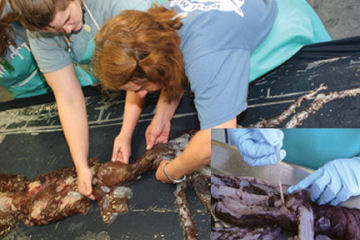Big squid
Florida fishermen recently hauled in a squid that's like no other ever found in the Atlantic Ocean.
By Emily Sohn
Fishermen in Florida recently discovered the remains of a humongous squid unlike any creature ever seen in the Atlantic Ocean. The creature’s Jell-O-like body wasn’t completely intact, but the living creature was definitely longer than the combined height of you and a handful of your friends. Scientists estimate that it was between 16 and 24 feet long.
 |
|
Marine biologists examine the head and arms of an unusually large squid. Remains of tentacle (held up in inset photo) are now just inches long, but they may have been 20 feet in length when they were whole.
|
| L. Mitchell/Mote Marine Lab.; (inset) V. Miller/Mote Marine Lab. |
A fishing boat pulled the squid out of the water in February, south of Key West, Fla. Surprised by the catch, the boat captain sent it to the Mote Marine Laboratory in Sarasota, Fla. There, squid expert Debra A. Ingrao immediately began studying the animal.
First, she took samples of its genetic material, or DNA. Next, she preserved the partially decomposed body to keep it from breaking down further. Then, she began dissecting it. She sent pictures of everything she did to squid experts around the world.
Most surprising to the researchers was the animal’s size. The remains measured more than 6 feet long, even though much of the animal’s body was missing. A fin had been chewed off one end of its body. And six of its eight tentacles were gone. Tentacles, which stretch off the base of a squid’s arms, tend to be between 7 and 12 times as long as the central part of the body, called the mantle.
“Most squid are 2 feet long or less,” Ingrao notes. This one was much bigger than that.
Based on Ingrao’s pictures, Michael Vecchione of the Smithsonian Institution in Washington, D.C., concluded that the squid was female. That’s because in the images, he could see a body part involved in egg production. Those parts were large, suggesting that the female was an adult.
So far, all information suggests that the squid belongs to a species called Asperoteuthis acanthoderma, Ingrao says. The identification is tricky, though, because fewer than 10 individuals of that species have ever been seen. And all of those sightings came from the Pacific or Indian Oceans—far away from the Atlantic.
By studying the slop in the squid’s stomach, the researchers are hoping to determine what the animal ate. Growth rings in the bones of its head might tell them how old the animal was. Other new information is bound to come out of the research.
“With animals this rare, every new find tells you a little more,” says Martin Collins of the British Antarctic Survey in Cambridge, England.
Studies of a smaller, related species suggest that gelatinous squid such as these float in deep, dark waters. Instead of chasing prey, as more muscular squid do, these creatures might simply capture their unsuspecting prey with suckers on the ends of their tentacles. The suckers could hold the prey until the animal moved in to slurp it up.
For now, all these theories are speculation. No one has ever seen one of these enormous squid alive.—







